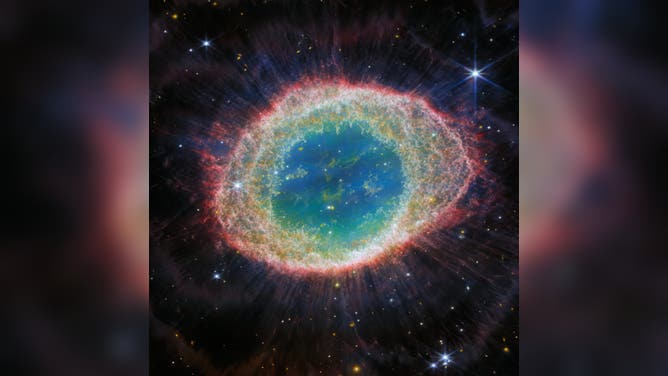James Webb Space Telescope captures new beauty of dying star
The ring nebula captured by James Webb Space Telescope's NIRCam is 2,500 light-years away and known as M57 and NHC6720. NIRCam's sensitivity captures new details of the structures within the celestial object.
See stunning images taken by the James Webb Space Telescope
The James Webb Space Telescope has released mesmerizing images of the deepest corners of our universe.
A ring nebula with its dying star has come to new life through the lens of NASA's James Webb Space Telescope.
JWST captured the sharpest view yet of a ring nebula in even more detail than the Southern Ring Nebula it first captured last year, according to NASA.
At the end of its life, a ring nebula displays beautiful colors and details once thought to be "simple, round objects with a single dying star at the center," according to Roger Wesson of Cardiff University.

The NASA/ESA/CSA James Webb Space Telescope has observed the well-known Ring Nebula with unprecedented detail. Formed by a star throwing off its outer layers as it runs out of fuel, the Ring Nebula is an archetypal planetary nebula. (Image Credit: ESA/Webb, NASA, CSA, M. Barlow (University College London), N. Cox (ACRI-ST), R. Wesson (Cardiff University)
(NASA)
Wesson is part of the Evolved Stars and their Nebulae in the JWST Era, or ESSENcE, team, an international group studying planetary nebulae.
According to NASA, a ring nebula is an excellent example of a planetary nebula, which includes an expanding shell of glowing gas expelled by a star late in its life. Our solar system's own Sun will create a planetary nebula when it begins dying but not anytime soon.
WEBB REVEALS GALAXIES IN EXQUISITE DETAIL
According to the Space Telescope Science Institute, the ring nebula captured by Webb’s Near-Infrared Camera (NIRCam) is 2,500 light-years away and known as M57 and NHC6720. NIRCam's sensitivity captures new details of the structures within the celestial object.
The image was captured just a few weeks after Webb started science operations in July 2022.
"When we first saw the images, we were stunned by the amount of detail in them," Wesson said. "The bright ring that gives the nebula its name is composed of about 20,000 individual clumps of dense molecular hydrogen gas, each of them about as massive as the Earth."
Another image using Web's Mid-InfraRed Instrument (MIRI) displays a faint halo outside the brightest ring.
Wesson said the image also contained new revelations for the ESSENcE team.

The NASA/ESA/CSA James Webb Space Telescope has observed the well-known Ring Nebula with unprecedented detail. Formed by a star throwing off its outer layers as it runs out of fuel, the Ring Nebula is an archetypal planetary nebula. (Image Credit: ESA/Webb, NASA, CSA, M. Barlow (University College London), N. Cox (ACRI-ST), R. Wesson (Cardiff University)
"A surprising revelation was the presence of up to ten regularly-spaced, concentric features within this faint halo. These arcs must have formed about every 280 years as the central star was shedding its outer layers," Wesson said.
The image hints at a possible companion star, making a binary star system.
"These rings suggest that there must be a companion star in the system, orbiting about as far away from the central star as Pluto does from our Sun," Wesson said. "As the dying star was throwing off its atmosphere, the companion star shaped the outflow and sculpted it. No previous telescope had the sensitivity and the spatial resolution to uncover this subtle effect."
As the team continues to study planetary nebulae, they could find more information about a possible binary companion star.
